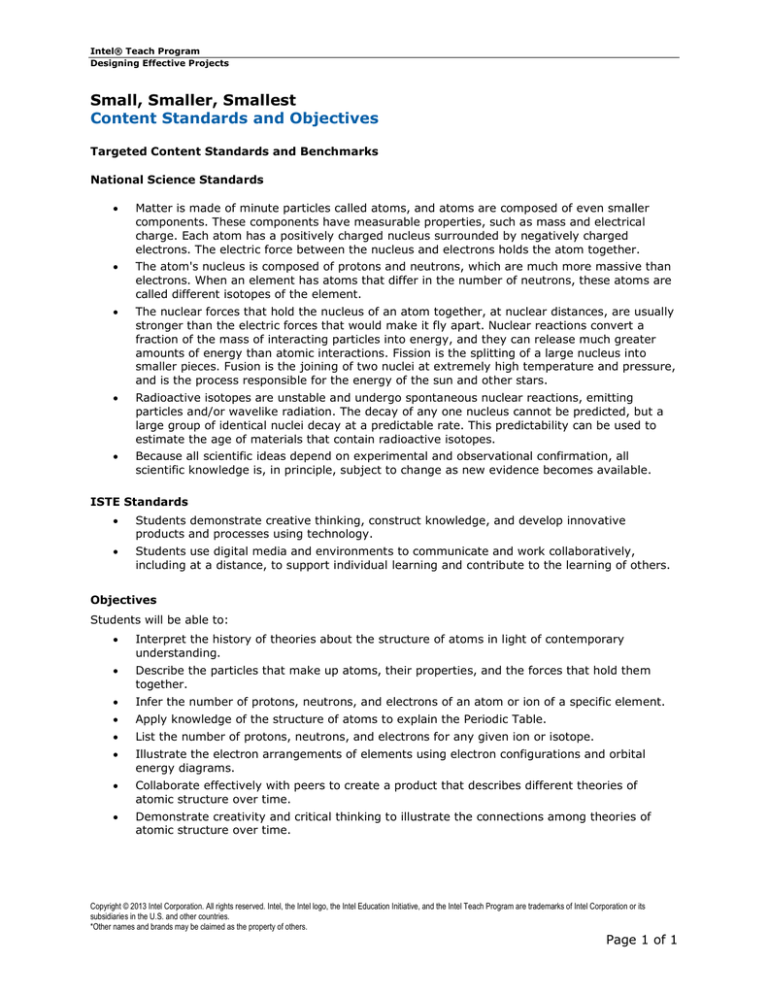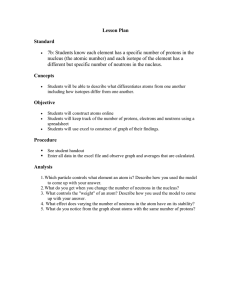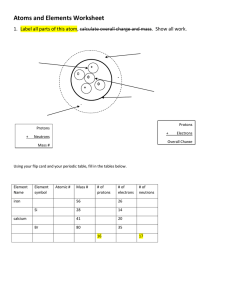
Intel® Teach Program
Designing Effective Projects
Small, Smaller, Smallest
Content Standards and Objectives
Targeted Content Standards and Benchmarks
National Science Standards
•
Matter is made of minute particles called atoms, and atoms are composed of even smaller
components. These components have measurable properties, such as mass and electrical
charge. Each atom has a positively charged nucleus surrounded by negatively charged
electrons. The electric force between the nucleus and electrons holds the atom together.
•
The atom's nucleus is composed of protons and neutrons, which are much more massive than
electrons. When an element has atoms that differ in the number of neutrons, these atoms are
called different isotopes of the element.
•
The nuclear forces that hold the nucleus of an atom together, at nuclear distances, are usually
stronger than the electric forces that would make it fly apart. Nuclear reactions convert a
fraction of the mass of interacting particles into energy, and they can release much greater
amounts of energy than atomic interactions. Fission is the splitting of a large nucleus into
smaller pieces. Fusion is the joining of two nuclei at extremely high temperature and pressure,
and is the process responsible for the energy of the sun and other stars.
•
Radioactive isotopes are unstable and undergo spontaneous nuclear reactions, emitting
particles and/or wavelike radiation. The decay of any one nucleus cannot be predicted, but a
large group of identical nuclei decay at a predictable rate. This predictability can be used to
estimate the age of materials that contain radioactive isotopes.
•
Because all scientific ideas depend on experimental and observational confirmation, all
scientific knowledge is, in principle, subject to change as new evidence becomes available.
ISTE Standards
•
Students demonstrate creative thinking, construct knowledge, and develop innovative
products and processes using technology.
•
Students use digital media and environments to communicate and work collaboratively,
including at a distance, to support individual learning and contribute to the learning of others.
Objectives
Students will be able to:
•
Interpret the history of theories about the structure of atoms in light of contemporary
understanding.
•
Describe the particles that make up atoms, their properties, and the forces that hold them
together.
•
Infer the number of protons, neutrons, and electrons of an atom or ion of a specific element.
•
Apply knowledge of the structure of atoms to explain the Periodic Table.
•
List the number of protons, neutrons, and electrons for any given ion or isotope.
•
Illustrate the electron arrangements of elements using electron configurations and orbital
energy diagrams.
•
Collaborate effectively with peers to create a product that describes different theories of
atomic structure over time.
•
Demonstrate creativity and critical thinking to illustrate the connections among theories of
atomic structure over time.
Copyright © 2013 Intel Corporation. All rights reserved. Intel, the Intel logo, the Intel Education Initiative, and the Intel Teach Program are trademarks of Intel Corporation or its
subsidiaries in the U.S. and other countries.
*Other names and brands may be claimed as the property of others.
Page 1 of 1




